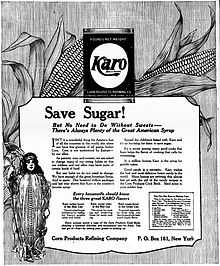Corn syrup

Corn syrup is a food syrup which is made from the starch of maize (called corn in some countries) and contains varying amounts of maltose and higher oligosaccharides, depending on the grade. Corn syrup is used in foods to soften texture, add volume, prevent crystallization of sugar, and enhance flavor. Corn syrup is distinct from high-fructose corn syrup (HFCS), which is manufactured from corn syrup by converting a large proportion of its glucose into fructose using the enzyme D-xylose isomerase, thus producing a sweeter compound due to higher levels of fructose.
The more general term glucose syrup is often used synonymously with corn syrup, since glucose syrup is in the United States most commonly made from corn starch.[1][2] Technically, glucose syrup is any liquid starch hydrolysate of mono-, di-, and higher-saccharides and can be made from any source of starch; wheat, tapioca and potatoes are the most common other sources.[3][4][5]
Commercial preparation
Historically, corn syrup was produced by combining corn starch with dilute hydrochloric acid, and then heating the mixture under pressure. The process was invented by Gottlieb Kirchhoff in 1812. Currently, corn syrup is obtained through a multi-step bioprocess. First, the enzyme α-amylase is added to a mixture of corn starch and water. α-amylase is secreted by various species of the bacterium Bacillus; the enzyme is isolated from the liquid in which the bacteria are grown. The enzyme breaks down the starch into oligosaccharides, which are then broken into glucose molecules by adding the enzyme glucoamylase, known also as "γ-amylase". Glucoamylase is secreted by various species of the fungus Aspergillus; the enzyme is isolated from the liquid in which the fungus is grown. The glucose can then be transformed into fructose by passing the glucose through a column that is loaded with the enzyme D-xylose isomerase, an enzyme that is isolated from the growth medium of any of several bacteria.[6]
Corn syrup is produced from number 2 yellow dent corn.[7] When wet milled, about 2.3 litres of corn are required to yield an average of 947g of starch, to produce 1 kg of glucose or dextrose syrup. A bushel (25 kg) of corn will yield an average of 31.5 pounds (14.3 kg) of starch, which in turn will yield about 33.3 pounds (15.1 kg) of syrup. Thus, it takes about 2,300 litres of corn to produce a tonne of glucose syrup, or 60 bushels (1524 kg) of corn to produce one short ton.[8][9]
The viscosity and sweetness of the syrup depends on the extent to which the hydrolysis reaction has been carried out. To distinguish different grades of syrup, they are rated according to their dextrose equivalent (DE). Most commercially available corn syrups are approximately 1/3 glucose by weight.
Some commercial corn syrup products are actually a composition of syrups.
- Composition Light corn syrup is a combination of corn syrup and high fructose corn syrup, seasoned with vanilla flavor and salt. Light corn syrup is clear and tastes moderately sweet.
- Composition Dark corn syrup is a combination of corn syrup and molasses (or Refiners' syrup[10]), caramel color and flavor, salt, and the preservative sodium benzoate. Dark corn syrup is a warm brown color and tastes much stronger than light corn syrup. Molasses in dark corn syrup enhances its flavor and color.
Uses

Corn syrup's major uses in commercially prepared foods are as a thickener, a sweetener and as a humectant – an ingredient that retains moisture and thus maintains a food's freshness.[11]
In the United States, cane sugar quotas raise the price of sugar;[12] hence, domestically produced corn syrup and high-fructose corn syrup are less expensive alternatives that are often used in American-made processed and mass-produced foods, candies, soft drinks and fruit drinks to help control cost.[11]
Glucose syrup was the primary corn sweetener in the United States prior to the expanded use of high fructose corn syrup production. HFCS is a variant in which other enzymes are used to convert some of the glucose into fructose. The resulting syrup is sweeter and more soluble. Corn syrup is also available as a retail product.
If mixed with sugar, water and cream of tartar corn syrup can be used to make sugar glass.
See also
References
- ↑ Structure of the world starch market, European Commission - Directorate Agricultural and Rural development, Evaluation of the Community Policy for Starch and Starch Products, Final report 2002, Chapter 1, page 3
- ↑ "Sugar Association Alternative Carbohydrate Sweeteners".
- ↑ Wheat starch, Application, International Starch Institute Denmark
- ↑ Global casave outlook; Guy Henry, Andrew Westby; 2007; page 600
- ↑ "International Starch Association Starch and Glucose Glossary".
- ↑ Martin Chaplin and Christopher Bucke, Enzyme Technology (Cambridge, England: Cambridge University Press, 1990), pages 146-154. Available on-line at: London South Bank University: Enzyme Technology. See "Chapter 4: The large-scale use of enzymes in solution", sections:
- ↑ "Dent corn" (Zea mays var. indentata) is so called because the tops of its kernels are slightly indented. See Merriam-Webster dictionary.
- ↑ "Enzymatic starch hydrolysis: background".
- ↑ Trends in U.S. production and use of glucose syrup and dextrose, 1965-1990, and prospects for the future - U.S. Dept. of Agriculture, Economic Research Service report
- ↑ "Karo Syrup - FAQ". Karo. ACH Food Companies, Inc. Retrieved 24 October 2014.
- ↑ 11.0 11.1 Knehr, Elaine. "Carbohydrate Sweeteners". Virgo Publishing. Retrieved 2008-10-17.
- ↑ "U.S. Sugar Import Program". USDA. Retrieved 2009-03-21.
External links
- How corn syrup is causing obesity.
- How corn is turned into corn syrup.
- Oregon State University Food Resource: Corn Syrup
| ||||||||||||||||||||||||||||||||||||||||||||||
